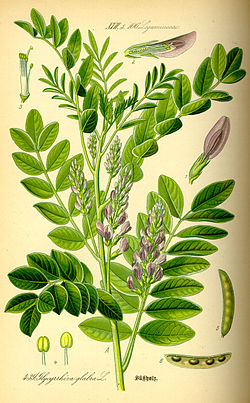| Liquorice | |
|---|---|
 | |
| Scientific classification | |
| Kingdom: | Plantae |
| Clade: | Tracheophytes |
| Clade: | Angiosperms |
| Clade: | Eudicots |
| Clade: | Rosids |
| Order: | Fabales |
| Family: | Fabaceae |
| Subfamily: | Faboideae |
| Clade: | Inverted repeat-lacking clade |
| Genus: | Glycyrrhiza |
| Species: | G. glabra |
| Binomial name | |
| Glycyrrhiza glabra | |
| Synonyms [3] [4] [5] | |
| |
Liquorice (Commonwealth English) or licorice (American English; see spelling differences; IPA: /ˈlɪkərɪʃ,-ɪs/ LIK-ər-ish, -iss) [6] [7] is the common name of Glycyrrhiza glabra, a flowering plant of the bean family Fabaceae, from the root of which a sweet, aromatic flavouring is extracted. [8]
Contents
- Etymology
- Description
- Chemistry
- Cultivation and uses
- Tobacco
- Food and confectionery
- Research
- Traditional medicine
- Fungicide
- Adverse effects
- Consumption levels
- Physiological effects
- Potential for toxicity
- Pregnancy
- Gallery
- References
- External links
The liquorice plant is an herbaceous perennial legume native to West Asia, Tropical Asia, North Africa, and Southern Europe. [2] Liquorice is used as a flavouring in confectionery, tobacco, beverages, and pharmaceuticals, and is marketed as a dietary supplement. [8] [9]
Liquorice extracts have been used in herbalism and traditional medicine. [8] Excessive consumption of liquorice (more than 2 mg/kg [0.91 mg/lb] per day of pure glycyrrhizinic acid, a key component of liquorice) can lead to undesirable consequences. Clinically, it is suspected that overindulgence in liquorice may manifest as unexplained hypertension, low blood potassium levels (hypokalemia), and muscle weakness in individuals. [8] [9] [10] Consuming liquorice root extract should be avoided during pregnancy. [8] [9] [10]










